service Acura TSX 2010 Owner's Guide
[x] Cancel search | Manufacturer: ACURA, Model Year: 2010, Model line: TSX, Model: Acura TSX 2010Pages: 524, PDF Size: 12.34 MB
Page 352 of 524

If the system still detects a leak in
the vehicle’s evaporative emissions
system, the malf unction indicator
lamp (MIL) comes on. If the f uel f ill
cap was not already tightened, turn
the engine of f , and check or
retighten the f uel f ill cap until it
clicks at least once. The MIL should
go off after several days of normal
driving once the cap is tightened or
replaced. If the MIL does not go of f ,
have your vehicle inspected by a
dealer. For more inf ormation, see
page . The ‘‘TIGHTEN FUEL CAP’’
message will appear each time you
restart the engine until the system
turns the message off.
Turn the engine of f , and conf irm the
f uel f ill cap is installed. If it is, loosen
it, then retighten it until it clicks at
least once. The message should go off after several days of normal
driving once you tighten or replace
thefuelfillcap.Toscrolltoanother
message, press the INFO button.
Your vehicle’s on board diagnostic
system will detect a loose or missing
f uel f ill cap as an evaporative system
leak. The f irst time a leak is detected
a ‘‘TIGHTEN FUEL CAP’’ message
appears on the multi-inf ormation
display.
Screw the fuel fill cap back on
until it clicks at least once. If you
do not properly tighten the cap,
you will see a ‘‘TIGHTEN FUEL
CAP’’ message on the multi-
inf ormation display. If the system
still detects an evaporative system
leak af ter retightening the cap, the
malf unction indicator lamp may
come on (see page ).
Push the f uel f ill door closed until
it latches. If the door won’t close
f ully, do not f orce it. Unlock the
drivers door f irst.
6.
7.
472
472
Service Station Procedure
Tighten Fuel Cap Message
Bef ore Driving
349
The f uel door and its latching
mechanism can be permanently
damaged if the f uel door is f orced
closed when the driver’s door is
locked.
2010 TSX
Page 353 of 524

Reach in between the hood and
the f ront grille with your f ingers.
The hood latch handle is above
the ‘‘A’’ logo. Push this handle up
to the right until it releases the
hood. Lif t the hood.
Park the vehicle, and set the
parking brake. Pull the hood
release handle located under the
lower lef t corner of the dashboard.
The hood will pop up slightly. If the hood latch handle moves stif f ly,
or if you can open the hood without
lif ting the handle, the mechanism
should be cleaned and lubricated.
2.
1.
Service Station Procedure
Opening and Closing the Hood
350
LATCH
HOOD RELEASE HANDLE
2010 TSX
Page 354 of 524
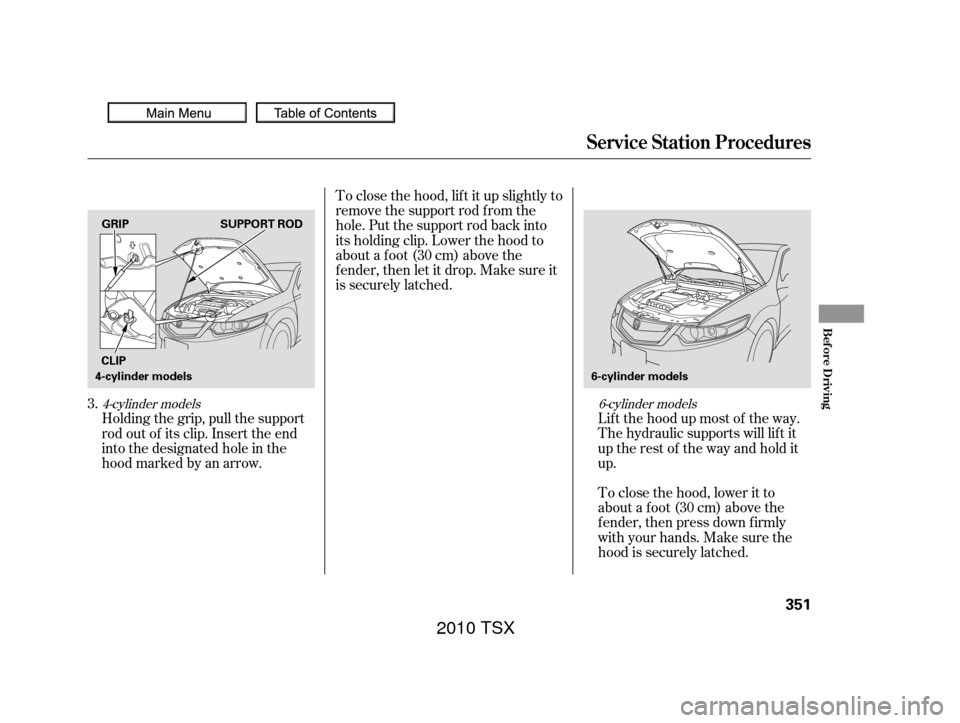
Lif t the hood up most of the way.
The hydraulic supports will lif t it
uptherestof thewayandholdit
up.
To close the hood, lif t it up slightly to
remove the support rod f rom the
hole. Put the support rod back into
its holding clip. Lower the hood to
about a f oot (30 cm) above the
f ender, then let it drop. Make sure it
is securely latched.
To close the hood, lower it to
about a f oot (30 cm) above the
f ender, then press down f irmly
with your hands. Make sure the
hood is securely latched.
Holding the grip, pull the support
rod out of its clip. Insert the end
into the designated hole in the
hood marked by an arrow.
3.
4-cylinder models
6-cylinder models
Service Station Procedures
Bef ore Driving
351
CLIPSUPPORT ROD
GRIP
4-cylinder models 6-cylinder models
2010 TSX
Page 355 of 524

Wipe the dipstick with a clean
cloth or paper towel.
Wait a f ew minutes af ter turning the
engine of f bef ore you check the oil. Park the vehicle on a level surf ace.
Remove the dipstick again, and
check the level. It should be
between the upper and lower
marks.
Insert the dipstick all the way back
into its hole.
Remove the dipstick (orange
handle/loop).
1.
2. 3.
4.
Oil Check
Service Station Procedure
352
UPPER MARK
LOWER MARK
DIPSTICK (orange handle)
4-cylinder models 4-cylinder models
6-cylinder models
2010 TSX
Page 356 of 524
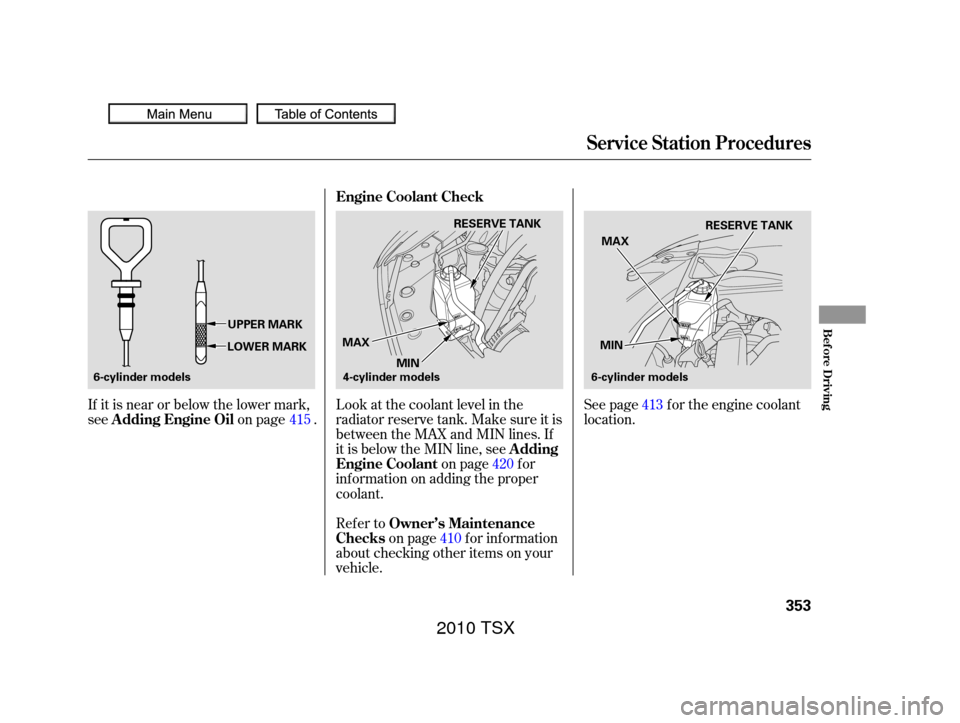
Look at the coolant level in the
radiator reserve tank. Make sure it is
between the MAX and MIN lines. If
it is below the MIN line, seeon page f or
inf ormation on adding the proper
coolant.
Refer to on page f or inf ormation
about checking other items on your
vehicle.
If it is near or below the lower mark,
see
on page . See page f or the engine coolant
location.
420
410
415
413
Service Station Procedures
Engine Coolant Check
A dding
Engine Coolant
Owner’s Maintenance
Checks
A dding Engine Oil
Bef ore Driving
353
UPPER MARK
LOWER MARK MAX
MIN RESERVE TANK
MAX MIN RESERVE TANK
6-cylinder models 6-cylinder models
4-cylinder models
2010 TSX
Page 389 of 524

Your vehicle is equipped with a tire
pressure monitoring system (TPMS)
that turns on every time you start the
engine and monitors the pressure in
your tires while driving.If you think you can saf ely drive a
short distance to a service station,
proceed slowly to the station, then
inflate the tire to the recommended
pressure.
Driving on a signif icantly under-
inf lated tire causes the tire to
overheat and can lead to tire failure.
Under-inf lation also reduces f uel
efficiency and tire tread life, and may
af f ect the vehicle’s handling and
stopping ability.
Becausetirepressurevariesby
temperature and other conditions,
the low tire pressure/TPMS
indicator may come on unexpectedly. If the tire is flat, or if the tire
pressure is too low to continue
driving, replace the tire with the
compact spare tire (see page ).
Each tire has its own pressure
sensor. If the air pressure of a tire
becomes signif icantly low, the
sensor in that tire immediately sends
a signal that causes the low tire
pressure/TPMS indicator in the
instrument panel to come on. If this
happens, you will see which tire is
losing pressure on the multi-
inf ormation display along with a
‘‘CHECK TIRE PRESSURE’’
message. It is possible that the pressures
shown on the multi-inf ormation
display and the pressures you
manually measure are slightly
dif f erent.
If the dif f erence is signif icant or you
cannot make the low tire pressure/
TPMS indicator and message on the
multi-inf ormation display go out af ter
inf lating the tires to the specif ied
values, have your dealer check the
system as soon as possible. When the low tire pressure/TPMS
indicator is on, one or more of your
tires is signif icantly underinf lated.
Youshouldstopandcheckyourtires
as soon as possible, and inflate them
to the proper pressure as indicated
on the vehicle’s tire inf ormation
placard.
458
Low Tire Pressure/
TPMS Indicator
Tire Pressure Monitoring System (TPMS)
386
2010 TSX
Page 393 of 524
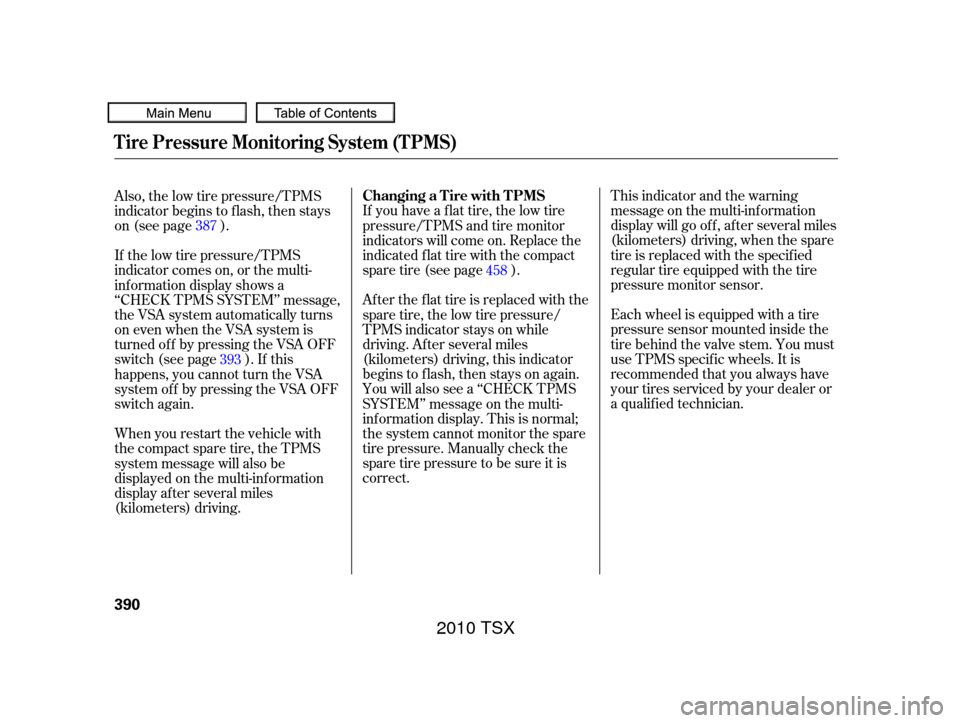
This indicator and the warning
message on the multi-inf ormation
display will go of f , af ter several miles
(kilometers) driving, when the spare
tire is replaced with the specified
regular tire equipped with the tire
pressure monitor sensor.
Each wheel is equipped with a tire
pressure sensor mounted inside the
tire behind the valve stem. You must
use TPMS specif ic wheels. It is
recommended that you always have
your tires serviced by your dealer or
a qualif ied technician.
If you have a f lat tire, the low tire
pressure/TPMS and tire monitor
indicators will come on. Replace the
indicated f lat tire with the compact
sparetire(seepage ).
After the flat tire is replaced with the
spare tire, the low tire pressure/
TPMS indicator stays on while
driving. Af ter several miles
(kilometers) driving, this indicator
begins to f lash, then stays on again.
You will also see a ‘‘CHECK TPMS
SYSTEM’’ message on the multi-
inf ormation display. This is normal;
the system cannot monitor the spare
tire pressure. Manually check the
sparetirepressuretobesureitis
correct.
Also, the low tire pressure/TPMS
indicator begins to f lash, then stays
on (see page ).
If the low tire pressure/TPMS
indicator comes on, or the multi-
inf ormation display shows a
‘‘CHECK TPMS SYSTEM’’ message,
the VSA system automatically turns
on even when the VSA system is
turned of f by pressing the VSA OFF
switch (see page ). If this
happens, you cannot turn the VSA
system of f by pressing the VSA OFF
switch again.
When you restart the vehicle with
thecompactsparetire,theTPMS
system message will also be
displayed on the multi-inf ormation
display af ter several miles
(kilometers) driving.
458
393
387
Tire Pressure Monitoring System (TPMS)
Changing a T ire with T PMS
390
2010 TSX
Page 400 of 524
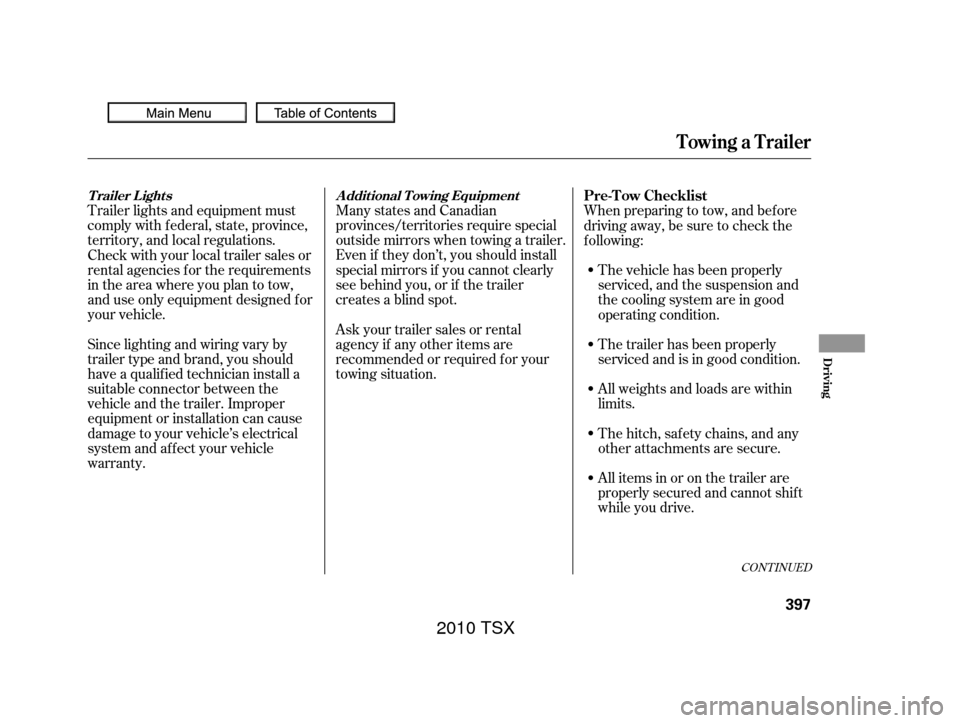
Many states and Canadian
provinces/territories require special
outside mirrors when towing a trailer.
Even if they don’t, you should install
special mirrors if you cannot clearly
see behind you, or if the trailer
creates a blind spot.
Trailer lights and equipment must
comply with f ederal, state, province,
territory, and local regulations.
Check with your local trailer sales or
rental agencies f or the requirements
in the area where you plan to tow,
and use only equipment designed f or
your vehicle.
Since lighting and wiring vary by
trailer type and brand, you should
have a qualif ied technician install a
suitable connector between the
vehicle and the trailer. Improper
equipment or installation can cause
damage to your vehicle’s electrical
system and af f ect your vehicle
warranty. When preparing to tow, and bef ore
driving away, be sure to check the
f ollowing:
The trailer has been properly
serviced and is in good condition.
Thehitch,safetychains,andany
other attachments are secure.
All items in or on the trailer are
properly secured and cannot shif t
while you drive. All weights and loads are within
limits. The vehicle has been properly
serviced, and the suspension and
the cooling system are in good
operating condition.
Askyourtrailersalesorrental
agency if any other items are
recommended or required f or your
towing situation.
CONT INUED
T railer L ight s A ddit ional T owing Equipment
Towing a Trailer
Pre-T ow Checklist
Driving
397
2010 TSX
Page 404 of 524
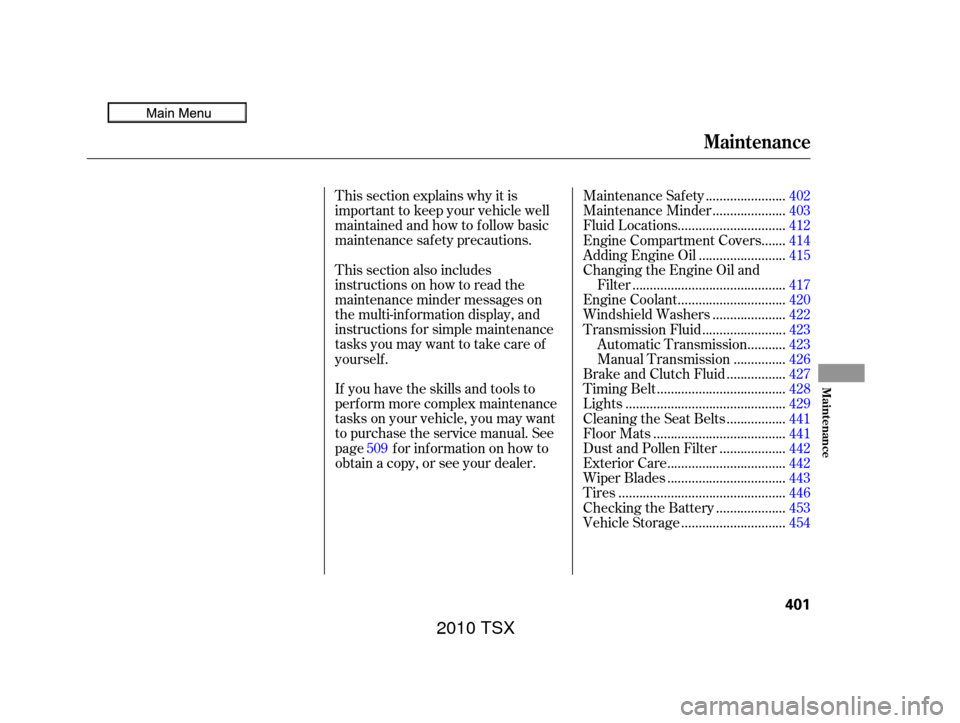
This section explains why it is
important to keep your vehicle well
maintained and how to f ollow basic
maintenance saf ety precautions.
This section also includes
instructions on how to read the
maintenance minder messages on
the multi-information display, and
instructions f or simple maintenance
tasks you may want to take care of
yourself .
If you have the skills and tools to
perf orm more complex maintenance
tasks on your vehicle, you may want
to purchase the service manual. See
page f or inf ormation on how to
obtain a copy, or see your dealer.......................
Maintenance Saf ety .402
....................
Maintenance Minder . 403
..............................
Fluid Locations .412
......
Engine Compartment Covers . 414
........................
Adding Engine Oil .415
Changing the Engine Oil and ...........................................
Filter .417
..............................
Engine Coolant .420
....................
Windshield Washers .422
.......................
Transmission Fluid .423
..........
Automatic Transmission . 423
..............
Manual Transmission . 426
................
Brake and Clutch Fluid . 427
....................................
Timing Belt .428
.............................................
Lights .429
................
Cleaning the Seat Belts . 441
.....................................
Floor Mats .441
..................
DustandPollenFilter . 442
.................................
Exterior Care .442
.................................
Wiper Blades .443
...............................................
Tires .446
...................
Checking the Battery . 453
.............................
Vehicle Storage .454
509
Maintenance
Maint enance
401
2010 TSX
Page 405 of 524

All service items not detailed in this
section should be perf ormed by a
certif ied technician or other qualif ied
mechanic.
To eliminate potential hazards, read
the instructions bef ore you begin,
and make sure you have the tools
and skills required.Make sure your vehicle is parked
on level ground, the parking brake
is set, and the engine is of f .
Some of the most important saf ety
precautions are given here. However,
we cannot warn you of every
conceivable hazard that can arise in
perf orming maintenance. Only you
can decide whether or not you
should perf orm a given task.Do
not run the engine unless
instructed to do so.
Let the
engine and exhaust system cool
down bef ore touching any parts. Be sure
there is adequate ventilation
whenever you operate the
engine.
Wear eye protection and
protective clothing when working
with the battery or compressed air. To reduce the possibility of f ire or
explosion, keep cigarettes, sparks,
and flames away from the battery
and all f uel-related parts. To clean parts, use a commercially
available degreaser or parts
cleaner, not gasoline.
Maintenance Saf ety
Important Saf ety Precautions Injury f rom moving parts.
Burns f rom hot parts. Carbon Monoxide poison
f rom engine exhaust.
Potential Vehicle Hazards
402
Failure to properly follow
maintenance instructions and
precautions can cause you to
be seriously hurt or killed.
Always follow the procedures
and precautions in this owner’s
manual.
Improperly maintaining this
vehicle, or failing to correct a
problem before driving can
cause a crash in which you can
be seriously hurt or killed.
Always follow the inspection
and maintenance
recommendations and
schedules in this owner’s
manual.
2010 TSX